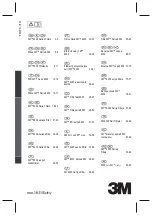
4.3.1 PEX Designation Code
RAUPEX pipe is further identi
fi
ed with a PEX Material Designation
code in accordance to ASTM F876. The PEX Designation Code is the
abbreviation for the material - PEX - followed by four numerals.
The PEX Designation Code for RAUPEX white UV shield pipe is
PEX 3306
The
fi
rst numeral
(3)
refers to the chlorine resistance in one of four
categories, when tested in accordance with ASTM Test Method F2023
and evaluated in accordance with ASTM F876. This measurement
indicates the allowable hours of 140°F water recirculation in 1 day.
0 = none
1 = 4 hours
e.g., 25% of lifetime
3 = 12 hours
e.g., 50% of lifetime
5 = 24 hours
e.g., 100% of lifetime
The second numeral
(3)
refers to UV resistance in one of four
categories, when tested in accordance with ASTM Test Method F2657
and evaluated in accordance with ASTM F876. The measurement
indicates the allowable time pipe can be exposed to UV without being
compromised.
0 = none
1 = 1 month
2 = 3 months
3 = 6 months
The third and fourth numerals
(06)
refer to the Hydrostatic Design
Stress for water at 73°F in hundreds of psi. The standard pressure
rating at 73°F is derived from this measurement.
06 = 630 psi
4.4 Pressure and Temperature Ratings
The maximum temperature and pressure ratings of RAUPEX pipe are
in accordance to ASTM F876, CSA B137.5 and PPI TR-3. The
designer shall determine the actual conditions and apply the appropri-
ate and additional design factors as required for any particular project.
According to the REHAU
PEXa Limited Warranty
, the RAUPEX pipe
warranty period is for operating conditions at or below 180°F (82.2°C)
in permitted applications when the handling, use, installation and
maintenance continually complies with all REHAU
Technical
Guidelines
.
Table 4.3: RAUPEX White UV Shield Pressure and Temperature Ratings
RAUPEX White UV shield Pipe
Maximum Pressures and Temperatures
Design Factors
160 psi @ 73.4°F (1055 kPa @ 23°C)
0.50 (per ASTM F876, CSA B137.5)
130 psi @ 120°F (900 kPa @ 49°C)
0.50 (per ASTM F876, CSA B137.5)
100 psi @ 180°F (690 kPa @ 82.2°C)
0.50 (per ASTM F876, CSA B137.5)
4.5 Excessive Temperature and Pressure Capability
Temperature and pressure (T&P) relief valves are safety mechanisms
in case the system overheats (mandatory in hot water distribution
systems). These valves act quickly to relieve excess temperature or
pressure if either one of these conditions is reached. In the event of a
water heating system failure or T&P relief valve failure, RAUPEX pipe
has been tested to accommodate short-term exposure conditions of
210°F (99°C) at 150 psi (10 bar) for 48 hours.
NOTICE
Failure to follow pressure and temperature limits may damage the pipe
resulting in leaks and operational failures, and will negate any
warranty provided by REHAU for RAUPEX pipes. The designer must
incorporate proper controls into the system to ensure the pressure and
temperature capability of the pipe is not exceeded.
4.6 Corrosion Resistance
RAUPEX pipe is non-reactive and displays excellent corrosion
resistance. Corrosion is a process that requires electrically conductive
materials and occurs on metals. PEXa, being a dielectric, does not
corrode like metal pipes. PEXa also resists the buildup of scale which
is common with copper pipe.
4.7 Chlorine Resistance
RAUPEX pipe has been tested in accordance with ASTM F2023,
Standard Test Method for Evaluating the Oxidative Resistance of
Crosslinked Polyethylene (PEX) Tubing and Systems to Hot Chlorinated
Water
as required in ASTM F876. RAUPEX pipe exceeds the minimum
extrapolated test lifetime as certi
fi
ed by NSF for cold water applica-
tions, intermittent hot water applications and timed hot water
applications.
This recommendation applies to RAUPEX white UV shield pipes for
cold water and intermittent hot water applications (25% @ 140°F,
75% @ 73°F) and for timed hot water recirculation systems for up to
12 hours per day (50% @ 140°F, 50% @ 73°F). The ASTM F876
standard includes designation codes for these applications which are
included on the print line of RAUPEX pipes.
4.8 Ultraviolet Resistance
All polymers are susceptible to damage from exposure to the
ultraviolet (UV) radiation in sunlight. PEX pipes can be designed to
protect against short-term UV damage, but after some time, UV
radiation will reduce the lifetime of the pipe. The extent of the
reduction depends on factors such as temperature, pressure and
chlorination levels in potable water. Excessive UV exposure will reduce
the lifetime of the PEXa pipe.
9










































